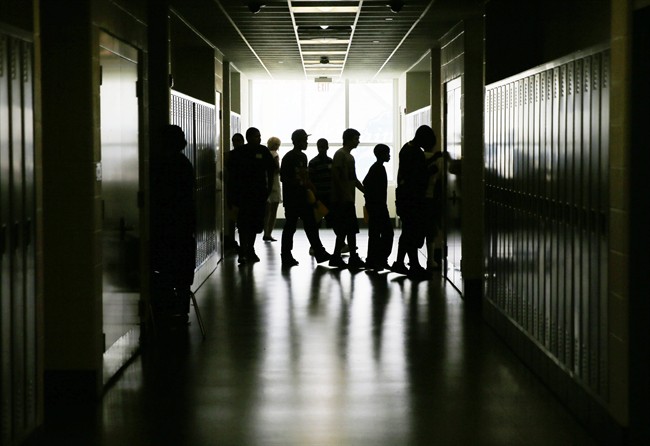NEW YORK – The troubles with kids these days … are not as common as they used to be. U.S. teens are having a lot less sex, they are drinking and using drugs less often, and they aren’t smoking as much, according a government survey of risky youth behaviours.

“I think you can call this the cautious generation,” said Bill Albert, spokesman for the National Campaign to Prevent Teen and Unplanned Pregnancy.
Among a decline in several risky behaviours, a sharp decline in sexual activity stood out to researchers.
The survey found 41 per cent said they had ever had sex, after it had been about 47 per cent over the previous decade. It also found marked declines last year in the proportion of students who said had sex recently, had sex before they were 13, and students who had had sex with four or more partners.
The results come from a study conducted every two years by the Centers of Disease Control and Prevention. The surveys included 16,000 students at 125 schools, both public and private. Participation was voluntary and required parental permission, but responses were anonymous. Results were released Thursday.
National surveys have seen a levelling off in recent years in the proportion of kids who said they had sex, after earlier declines. That led researchers to largely attribute continuing declines in teen pregnancies and abortions to more and better use of birth control.
But the new numbers suggest less sex is a factor, too. The drops are surprising enough that government officials said they’d like to see what the next survey shows to make sure it’s not a statistical blip.
If it is a true drop, the reason is not clear why. “We’re trying to look at reasons why this might be happening,” said Dr. Stephanie Zaza of the Centers for Disease Control and Prevention, who oversees the survey.
One possibility, Albert said:
“It may be that parking at Lookout Point has given way to texting from your mom’s living room couch,” he said.
READ MORE: Online porn, sexting should be included in sex ed. curriculum, Alberta professor says
In the new survey, about 42 per cent said they played video or computer games or used a computer for something that was not school work for more than three hours per day on an average school day.
Beth Mattey, who until last year was a nurse at a high school in Wilmington, Delaware, suggested a factor may be how much more common it is for teens to openly discuss sex and sexual orientation.
“We want kids to have a healthy sexuality built around self-respect and self-esteem,” said Mattey, who is now president of the National Association of School Nurses.
READ MORE: ‘Like spreading peanut butter’: Bad sex ed makes you believe the ridiculous
Why would more discussion of sex reduce the amount of sex kids are having? One theory: “Culturally we may have shifted away from sex being a taboo that adolescents would sort of reach out for,” said Beth Marshall, a Johns Hopkins University scientist focused on adolescent health.
- Naloxone-resistant street drug linked to 9 deaths in Eastern Canada seized in Alberta
- ‘She gets to be 10’: Ontario child’s heart donated to girl the same age
- Buzz kill? Gen Z less interested in coffee than older Canadians, survey shows
- Bird flu risk to humans an ‘enormous concern,’ WHO says. Here’s what to know
The survey found the 30 per cent of the students surveyed said they’d had sex in the previous three months, down from about 34 to 35 per cent reported in each of the previous six surveys.
About 11 per cent had four or more sex partners, down from the 14 to 15 per cent seen over the previous decade. And about 4 per cent said they’d had sex before they turned 13, down from 6 to 7 per cent.
Other findings from the survey:
SMOKING
Fewer than 11 per cent of the teens smoked a cigarette in the previous month — the lowest level since the government started doing the survey, when the rate was more than 27 per cent. But the fall is not surprising — another CDC survey has put the high school smoking rate at about 9 per cent.
DRINKING
Just under a third had at least one alcoholic drink in the 30 days before the survey, down from 35 per cent in the last survey and down from 45 per cent in 2007. About 63 per cent had ever had a drink, down from 66 per cent in 2013 and 75 per cent in 2007.
VAPING
The survey for the first time asked about electronic cigarettes, which have exploded in popularity in the past few years. It found about 24 per cent had used electronic cigarettes or vaping products in the previous month — a much higher estimate than seen in other recent CDC youth surveys. CDC officials noted that the surveys are done differently, so a variation in the numbers is not that surprising.
TOKING
A little under 22 per cent of teens said they used marijuana in the previous month. That’s down a bit from the previous two surveys. The proportion who said they had ever tried marijuana, and who had tried it before they were 13, also slid a bit. The finding is considered mildly surprising, but is consistent with drops in the use of other illegal drugs like heroin (2 per cent), cocaine (5 per cent), ecstasy (5 per cent), and hallucinogenic drugs like LSD (6 per cent).
USING PRESCRIPTION DRUGS
About 17 per cent of the surveyed students said they had taken prescription drugs without a prescription, in response to a question that listed as some possible examples painkillers like Oxycontin and Vicodin and ADHD drugs like Adderall and Ritalin. That statistic has been declining, but is still alarmingly high, Zaza said.

Comments